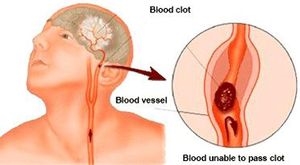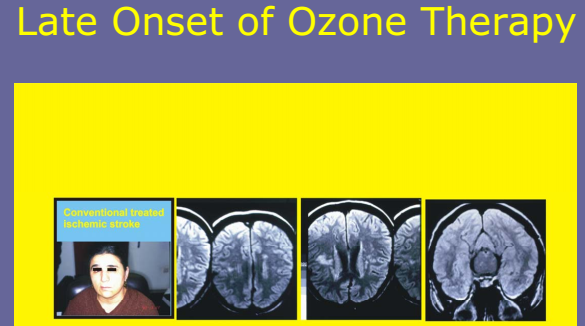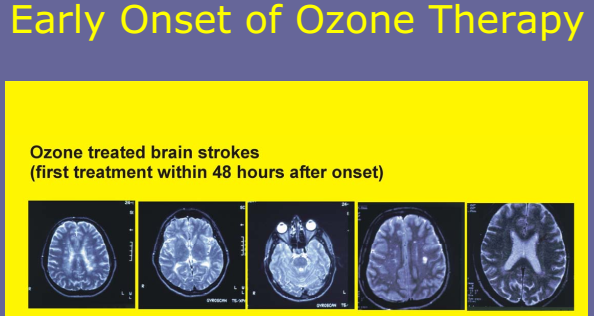Ozone therapy in ischemic stroke
Stroke is divided into ischemic (87%) and hemorrhagic (13%). Ischemic stroke occurs immediately after the blockage (embolization) of the cerebral artery.
In the USA, there are about 750,000 new cases per year, while in Russia, about 400,000. Mortality in the first month is 15-30%. The surviving part constitutes a major problem for the patient, the family, society, and the healthcare system.

The brain constitutes only 2% of body weight, but consumes 20% of oxygen. If it remains without blood for 5-8 minutes, it suffers irreversible damage: anoxia, edema, neuron death (loss of 1.9 million neurons/minute). Therefore, the sooner the treatment starts, the better the prognosis. Ideally, it should start within the first 90 minutes.
Even in the area surrounding the stroke (penumbra), within a few hours, progressive damage characterized by progressive hypoxia, glucose deficiency, increased lactic acid, edema, reduction of intracellular ATP, inhibition of protein synthesis, including neurotransmitters, occurs. If we do not intervene in time, this wider area suffers irreversible damage.
With the discovery of Tissue Plasminogen Activator (TPA), hopes were raised that by quickly dissolving the thrombus and reopening circulation, neuronal damage would be limited.
However, thrombolysis has its own limitations:
- The patient needs to reach the "stroke unit" within 3-4 hours. For developed countries, this is only possible in 20% of cases. But what about our country?
- After thrombolysis in the penumbra, formation of reperfusion edema occurs, which leads to irreversible neuron damage.
The "golden time" to save the nerve tissue in the penumbra is 5-12 hours (Prof. V.Bocci). According to Wasser, it extends up to 48 hours (if ozone therapy is given after 48 hours, it cannot avoid paralysis).
The goal of the therapy is to re-oxygenate the penumbra as quickly as possible, to reduce the edema in the brain tissue. This is achieved with ozone therapy, which:
- increases the release of oxygen towards ischemic tissues
- improves the rheological properties of blood
- eliminates toxins from the ischemic area
- activates glycolysis with an increase in ATP and 2,3 DPG
- reduces total cholesterol by 10-12% and β-lipoproteins by 7-10%.
- reduces the atherogenic coefficient by 12-15%

A. Ischemic stroke treated conventionally (irregular appearance of brain tissue)

B. Ischemic stroke treated with ozone therapy (regular appearance of brain tissue)
MRI images of the head: see the significant difference between a case treated conventionally (A) and another treated with ozone therapy (B)
Treatment: combines one of the systemic application forms of ozone (AHTma, FO, RI) with conventional therapy (nootropics, Ca-blockers, vitamins, antiplatelets, physiotherapy, etc.)
Positive results are seen after the first sessions:
- Reduces the intensity of headache
- Normalizes sleep
- Improves appetite
- Stabilizes blood pressure
- Subjective sensations like "pleasant fatigue" or "general comfort" during the application of systemic ozone
Some practical advice:
- After reading this article, make sure to read or re-read the article "Ozone therapy in atherosclerotic disorders"; only then will you understand that ozone therapy is indispensable in the prevention and treatment of the catastrophes brought by atherosclerosis – ischemic heart syndrome, myocardial infarction, brain sclerosis, ischemic stroke, and obliterating endarteritis.
- To prevent all these, two cycles per year of 10-12 systemic ozone sessions are enough. This would be ideal, as it aligns with the universal principle of medicine: it is easier to prevent than to treat.
- But it's never too late. Let's concretize it with ischemic stroke. It is experienced as a drama by the patient or their family. If the diagnosis "stroke" is made, then you have 3-4 hours to reach the "stroke unit" in the QSUT.
- If it's impossible for you to do so (you are far from Tirana, etc.) and the diagnosis "ischemic stroke" is confirmed (ozone therapy is not applied in hemorrhagic stroke), then seek the help of ozone therapy, which can save the brain from the severe consequences of the stroke. The sooner systemic ozone starts, the better, however, it should not be delayed beyond 48 hours – this is the last train!!!!!!